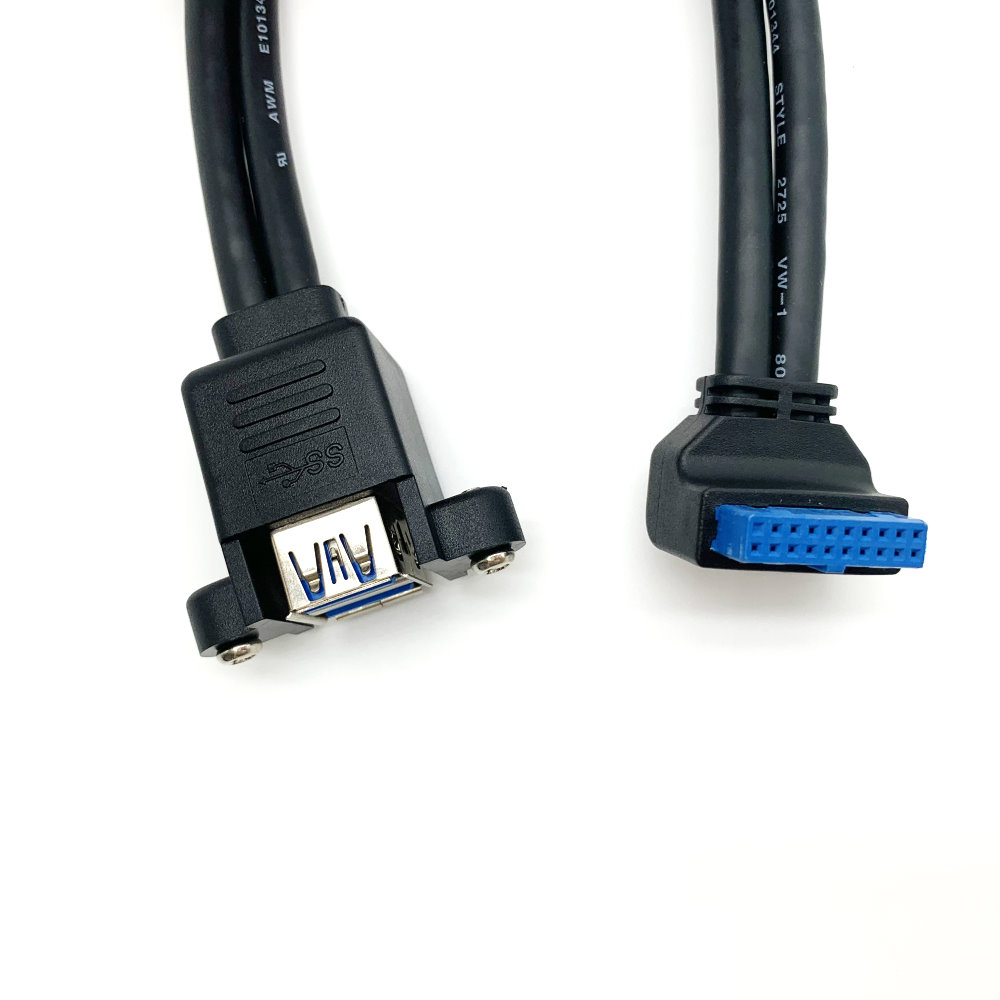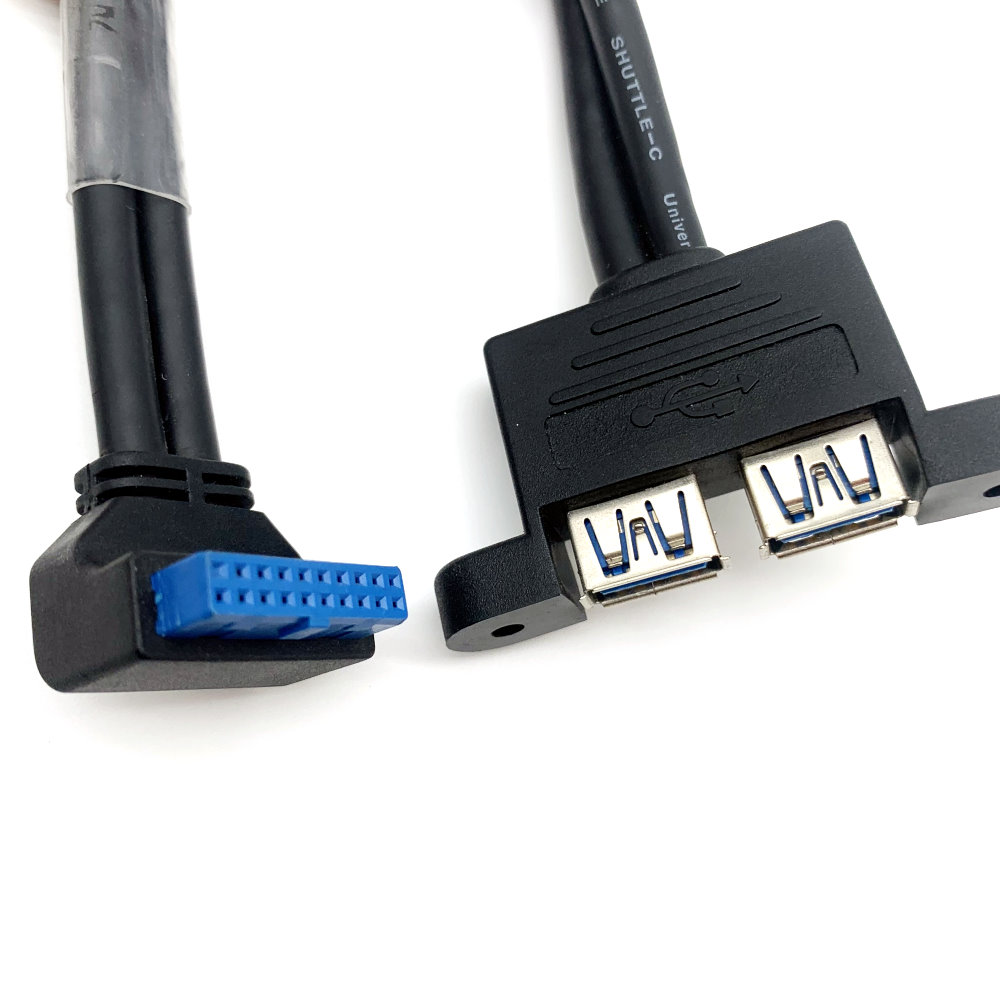USB3.0 adapter cable case adapter cable motherboard adapter cable 20pin to USB cable USB 19 hole adapter cable USB3.0 expansion
USB3.0 20pin (19 holes+1) to USB3.0 female (lockable panel) adapter cable
One end is a standard USB3.0 20pin (19 hole+1) female connector on the motherboard
One end is USB3.0 female (lockable panel)
USB3.0 20pin (19-pin) female connector direction:
Straight head: total length (USB3.0 adapter cable) about 34 cm
Upper bend: total length (USB3.0 adapter cable) about 34 cm
Lower bend: total length (USB3.0 adapter cable) about 33 cm
One end is USB3.0 female (lockable panel)


20pin to dual USB bus USB3.0 adapter cable case adapter cable motherboard adapter cable USB19 pin adapter cable lockable panel
USB3.0 20pin (19-pin) to dual USB3.0 bus
You can use this cable to connect to the computer motherboard USB3.0 20pin (19-pin) socket, converting it into two USB3.0 female sockets
One end is a USB3.0 dual female connector (with screw holes that can be locked on the panel)
One end is the standard USB3.0 20pin (19-pin) header on the motherboard
Cable length (including connector) 50 cm


U3-043 20pin to dual USB bus USB3.0 adapter cable case adapter motherboard adapter cable USB19 pin adapter cable lockable panel
USB3.0 20pin (19-pin) to dual USB3.0 bus
You can use this cable to connect to the computer motherboard USB3.0 20pin (19-pin) socket, converting it into two USB3.0 female sockets
One end is the standard USB3 on the motherboard. 0 20pin (19 pin) header
One end is a USB3.0 dual female connector (with screw holes that can be locked on the panel)
line length ( USB3.0 adapter cable ) 50 cm
USB 3.0 IDC-USB 3.0 AF connector
Product Description : Type: There are two main types of network cables: Ethernet and optical fiber network cables.Ethernet cables are typically used in general home and office environments, while fiber optic cables are used for high-speed data transmission over long distances.
Transmission rate: The transmission rate of a network line is an important indicator of its performance.Common rates include 10/100/1000 Mbps (gigabits per second, i.e. Gigabit network) and 10 Gbps (gigabits per second, i.e. billion network).
Standards: Network cables usually need to comply with specific standards. For example, Ethernet cables need to comply with the IEEE 802.3 standard.Different standards may have different transmission rates and characteristics.
Connector type: Network cable connectors usually include RJ-45 and optical connectors.RJ-45 is a common Ethernet connector, while optical connectors are used in fiber optic networks.
Anti-interference ability: High-quality network cables should have good anti-interference ability to ensure stable operation in high electromagnetic interference environments.
Length: The length of the network cable is also an important consideration, as a cable that is too long may affect signal stability and transmission rate.
Functions and features of network cable:
1. Transmission speed: The transmission speed of the network cable. The network cable can support high-speed data transmission, ensuring that users have faster connection speeds on the Internet.The transmission speeds of different levels of network lines are measured in megabits per second (Mbps) or bits per second (Gbps).For example, Cat 5e usually supports data transfer rates up to 1000 Mbps (1 Gbps), while Cat 6 can provide higher rates, reaching 10 Gbps.As for Cat 6a, it can support speeds up to 10 Gbps while maintaining high performance over longer distances.
2. Stability and reliability: The stability of the network line is crucial to maintaining the stability and reliability of the connection.Every time you want to buy a network cable, you will be confused by the different grades of network cables. This is crucial to avoid connection interruption or packet loss, especially in applications that require high reliability, such as in offices or gaming environments.
3. Anti-interference: Talk about the anti-interference performance of the network line.Some network cable designs can effectively reduce external signals or electromagnetic interference, ensuring that data transmission is not affected by external influences.This is especially important when using network equipment in busy environments.
4. Scope of application: Different levels of network cables have different scopes of application, such as whether they are suitable for home, office or special application scenarios.Some network cables may be suitable for long-distance connections, while others are suitable for short-distance connections.
5. Standards and Certifications: If the network cable meets specific standards or is certified.For example: the network cable complies with Cat 5e, Cat 6, Cat 6a and other standards, or has obtained relevant industry certifications.What is more special is the Cat. 7 network cable, because the Cat. 7 network cable is not based on the network TIA/EIA-568.B/.C/.D specifications developed by TIA/EIA (American Communications Industry Association/Electrical Machinery Industry Association). Its specification ISO/IEC 11801 Class does not formulate a Cat. 7 standard specification for RJ45 connectors, and test instrument manufacturers (such as FLUKE) do not have a standard basis to launch corresponding instruments and equipment for testing Cat. 7, making it difficult for users to target Cat. Standard testing at a rate of 7
6. Durability: The durability and quality of the network cable.Network cables manufactured using high-quality materials and processes are more resistant to physical damage and daily wear and tear, extending their service life.
7. Flexibility and easy installation: The high-quality network cable design is soft and easy to install.Flexibility and ease of installation can make network cables easier to adapt to different environments and cabling needs.
The grades of network cables are usually distinguished by Cat (Category) standards, such as Cat 5e, Cat 6, Cat 6a, etc. Each grade of network cable has different characteristics and supported speeds.Higher-rated network cables generally support higher data transfer rates.The speeds supported by different levels of network cables.Cat 5e typically supports data transfer rates up to 1000 Mbps (1 Gbps), while Cat 6 is capable of even higher rates, up to 10 Gbps.As for Cat 6a, it can support speeds up to 10 Gbps while maintaining high performance over longer distances.
When purchasing an internet cable, choosing the appropriate grade is crucial.If your network usage needs are relatively simple, such as a general home user or a small office, Cat 5e may be sufficient for daily needs.However, if you need to handle large amounts of data, video streaming, or other high-bandwidth applications, it is recommended to consider upgrading to Cat 6 or Cat 6a to ensure higher transfer rates and performance.
When selecting a network cable, in addition to the grade, you should also pay attention to the following factors to avoid unstable network transmission:
3. Network cable length and cabling environment: Consider the usage environment and required length of the network cable.Longer network cables may require higher grade specifications to ensure stable data transmission.
Shielding: Some network lines are shielded to reduce external interference.In environments where high stability is required, it may be wise to choose a shielded network cable.
4. Installation quality: Correct and professional installation has a great impact on the performance of network cables.Make sure the wiring is not damaged, not bent excessively, and avoid being too close to power cords or other electronic equipment.
Summary: When purchasing a network cable, you need to carefully consider the usage requirements, choose the appropriate grade and brand, and ensure good installation quality to avoid unstable network transmission.When selecting a network cable, you should evaluate your actual needs and expected usage environment.Lower Cat ratings may be sufficient for the average home and small office, while for applications requiring higher performance, you may want to consider a higher-rated network cable. Excellent quality, welcome to call us! Sales method: manufacturing, exporting
Export trade terms: CFR delivery terms including freight, CIF delivery terms including freight and insurance, FOB delivery port at departure port
Sales target market: Global
Payment method for inquiry: TT wire transfer
competitive characteristics
Unique designs or logos accepted: Special designs or logos accepted
Diverse designs: King Lai Electornics Co.,Ltd. provides diversified designs for USB3.0 upward and downward bending, case adapter, motherboard adapter 20pin to USB cable, USB 19-hole adapter cable expansion
Upward and downward bend USB3.0 chassis adapter cable, motherboard adapter cable 20pin to USB cable, USB 19-hole adapter cable expansion, accept original factory commissioned design and manufacturing ODM
Upward and downward bend USB3.0 chassis adapter cable, motherboard adapter cable 20pin to USB cable, USB 19-hole adapter cable expansion, accepted for original factory contract manufacturing OEM
























